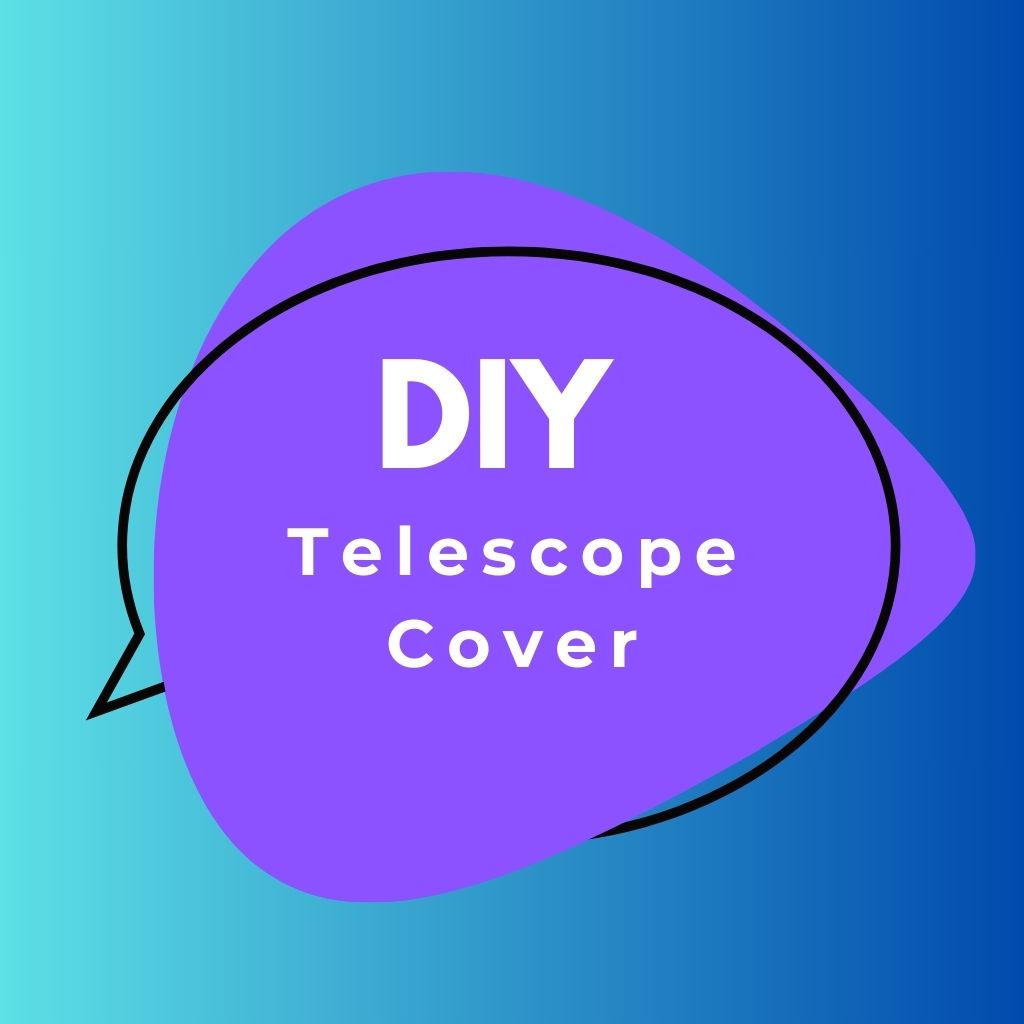This site contains affiliate links to products. I may receive a commission for purchases made through these links.
Stargazing is a fascinating hobby, and if you’re like me, your telescope is your best friend. But even the best of friends need protection. That’s where a DIY telescope cover comes into play. It’s a simple, cost-effective solution to protect your precious telescope from dust, moisture, and other potential damages.
Why Use a Telescope Cover?
Protection from Dust and Debris is the first reason to use a telescope cover. Even if I’m storing my telescope indoors, it’s not completely safe from dust. Tiny dust particles can creep into the optical elements and degrade the image quality. A telescope cover acts as a shield, preventing these harmful particles from reaching the sensitive elements of my telescope.
Prevention from Moisture Damage forms the next line of defense. Despite their robust appearance, telescopes are quite vulnerable to moisture. Changes in temperature can cause condensation to form inside the optical tube, damaging the internal components over time. This is especially true if I live in a humid area or if there’s a sudden drop in temperature overnight. A properly-fitted telescope cover will provide an extra layer of protection, guarding against these harmful effects of moisture.
A cover also defends against Physical Damages. Accidental collisions, scratches, or bumps can inflict physical damage on my telescope. While these may seem minor, they can add up over time resulting in a dent or two here or there on the body of my telescope. Using a cover can help safeguard the telescope, giving peace of mind to users like me.
Maintenance Ease forms the last consideration. Regular cleaning of a telescope can be a tedious task. The use of a cover significantly reduces the frequency of cleaning, saving me time and effort in the long run.
Table: Benefits of Using a Telescope Cover
| Benefits | Description |
|---|---|
| Protection from Dust and Debris | Prevents dust particles from degrading the image quality |
| Prevention from Moisture Damage | Guards against harmful effects of moisture |
| Physical Damage Protection | Shields against accidental scratches, collisions or bumps |
| Maintenance Ease | Reduces frequency of cleaning, saving time and effort |
Understandably, given these points the necessity of using a telescope cover becomes clear.
Benefits of DIY Telescope Cover
Creating your own DIY telescope cover brings a lot of benefits. It’s not just about the cost savings – it’s also about customization, convenience, and the sheer fun of doing it yourself.
Think about it. When you opt for a DIY telescope cover, you can tailor it to the exact measurements of your telescope. This customization aspect means you’ll get a perfect fit – something ready-made covers might not always offer. A cover that fits the telescope well offers maximum protection against dust and moisture.
Beyond the fit, a DIY cover also provides convenience. Anytime your cover wears out, you won’t have to search for a replacement or wait for it to arrive. With the right materials on hand, you can make your own – saving time and energy.
Here’s another perk – the learning experience and the fun of creating something with your own hands. Diving into a DIY project leads to a deeper understanding of how things work. Not to mention, it’s a great way to spend some quality time – with family, friends, or even just by yourself.
Lastly, let’s not overlook the potential cost savings. With the right materials, a DIY telescope cover can be quite inexpensive. Here’s a simple comparison between buying a ready-made cover and making your own:
| DIY Cover Cost | Ready-made Cover Cost | |
|---|---|---|
| Average | $10-$20 | $30-$60 |
Note: The values are approximate. The actual costs may vary.
The savings are clear. So why not protect your telescope, and dive into a DIY project that’s not only cost-effective but enjoyable too? By creating your own cover, you’re ensuring a custom fit, convenience, and a hands-on learning experience. Plus, you’ll probably find the process to be quite rewarding. With all these benefits, a DIY telescope cover is definitely a project worth considering.
Materials Needed for DIY Telescope Cover
For a successful DIY project, it’s important to have all the necessary materials at hand. In creating a telescope cover, you’d need the following essential items:
- Measurements of your telescope: This would be the first important piece of the puzzle. You’d need to have the exact dimensions of your telescope. You’d want a perfect fit to ensure maximum protection for your telescope.
- Fabric: Choose a fabric that’s durable, water-resistant, and able to prevent dust from coming through. A common choice is nylon as it meets all these requirements.
- Thermal padding: This is an optional item, yet it could provide an extra layer of protection against temperature fluctuations.
- Sewing materials: These include threads, needles, and possibly a sewing machine. If you’re not comfortable with sewing, adhesive fabric tape or even a good quality duct tape could do the job.
- Cord and cord lock: These items ensure that your cover stays secure.
- Pins: If you’re using a sewing machine or sewing by hand, pins may come in handy to help hold the fabric in place.
In the table below, I’ve summarized everything for quick reference.
| Items | Purpose |
|---|---|
| Measurements of your telescope | Tailor the cover to fit perfectly |
| Fabric | Protection from dust and water |
| Thermal padding | Protection against temperature fluctuations |
| Sewing materials | Sewing |
| Cord and cord lock | Secure the cover |
| Pins | Hold the fabric in place during sewing |
Remember, the goal is to create a DIY telescope cover that’s perfect for your specific telescope, so these materials should be modified as required. However, don’t get too caught up in the details. Enjoy the process, the creativity involved, and the learning experience with each step taken.
Having described the materials, we’ll next explore the process of creating your very own DIY telescope cover. Stay tuned as we delve into that.
Now that we’ve gathered all our materials let’s delve into the meat of the matter. The following steps provide a thorough process to ensure your handmade telescope cover fits like a glove.
To kick things off, unfold your chosen fabric on a flat surface, ensuring it’s free from any wrinkles.
First stop, measure the length and circumference of your telescope. I can’t stress enough how crucial these measurements are. Write these numbers down, you’ll need them for the fabric.
Step-by-Step Guide to Making a DIY Telescope Cover
Transfer these measurements onto the fabric, leaving an extra one centimeter around the edge for seam allowance. Go ahead and take your fabric scissors, cutting carefully along the measured line. You should now have a fabric length that’ll wrap around your telescope and stretch from one end to the other.
Preparing the Fabric
Next up is aligning your fabric so it’s ready for sewing. Flip your fabric piece so it’s “wrong” side up, then fold the edges over by one centimeter all around. Iron along these folds to hold them in place.
Once you’ve got your fabric prepped, it’s time to get down to the main event. Load up your sewing machine with thread that matches the color of your fabric. If you’re going the no-sew way that’s okay too; you can stick your folded fabric in place using adhesive fabric tape. Whichever method you choose, make sure the folded edges are secured well.
Adding the Cord and Lock
Once your fabric’s ready, let’s move onto the cord and cord lock. Sew or stick a tube at one end of the fabric. Run the cord through this tube and fit the cord lock on it. Make sure your cord is long enough to pull tight around your telescope.
Final Steps
The final step’s probably the easiest of all. Just wrap the cover around your telescope and pull the cord until it’s tight!
Remember, even if you’re not a professional seamstress, the most important thing is protecting your telescope – not winning a fashion contest! With these practical, effective steps, you’ll have a hard-wearing, functional telescope cover in no time.
Creating your own DIY telescope cover not only saves you money, it’s also a great opportunity to make something meaningful, personal, and truly one of a kind.
Tips and Tricks for Maintaining Your Telescope Cover
You’ve gone through the detailed process of creating your DIY telescope cover. Now, it’s important to ensure that the cover remains effective in protecting your telescope over time. I’ll provide some handy tips and tricks for maintaining your telescope cover in top-notch condition.
Routine Cleaning is Key
Regular cleaning is crucial to extend the life of your telescope cover. However, the type of cleaning method you’ll use depends on the fabric you’ve chosen. For most water-resistant fabrics, a quick wipe-down using a soft, damp cloth should suffice. There’s no need for heavy scrubbing or harsh cleaning agents, as these could damage the fabric’s protective coating.
Proper Storage When Not in Use
Yes, the cover is there to protect your telescope, but what protects the cover? When you’re not using the telescope cover, it’s best to store it in a cool, dry place out of direct sunlight. Sunlight can be tough on fabric, leading to fading and weakening over time. Rolling the cover instead of folding can also prevent creasing and potential damage to the fabric.
Handle with Care
No matter how durable your cover may be, rough handling can still lead to damage. When placing the cover on your telescope, do so gently and carefully. Don’t yank the cord too harshly when securing the cover, and be careful not to catch the fabric on any sharp edges on the telescope.
Inspect Regularly
Regular inspection of your telescope cover is also essential. This allows you to catch any potential issues like tears or wearing out of the fabric early on. It’s much simpler – and less costly – to perform small repairs when needed rather than replace the whole cover.
These basic, yet effective, maintenance practices can help your DIY telescope cover last as long as possible. Keeping these tips and tricks in mind will ensure that your cover remains up to the task of safeguarding your telescope. And remember, a well-cared-for telescope cover means a well-protected telescope.
Conclusion
I’ve walked you through the process of making a DIY telescope cover. It’s clear that taking precise measurements and choosing the right fabric are key. Whether you’re a pro at sewing or prefer using adhesive fabric tape, you can create a secure cover with a cord and cord lock. But it’s not just about creating the cover – it’s also about maintaining it.
With routine cleaning, proper storage, and regular inspection, your DIY telescope cover can last longer and provide the best protection for your telescope. So, don’t wait. Start crafting your own telescope cover today and ensure your telescope’s longevity.





